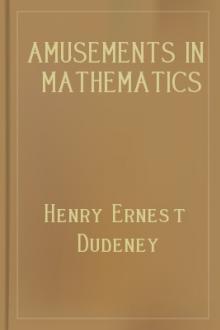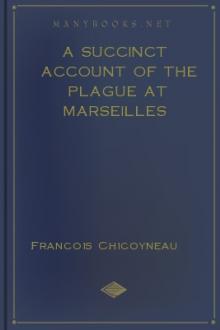Amusements in Mathematics, Henry Ernest Dudeney [books to read to be successful txt] 📗

- Author: Henry Ernest Dudeney
- Performer: 0486204731
Book online «Amusements in Mathematics, Henry Ernest Dudeney [books to read to be successful txt] 📗». Author Henry Ernest Dudeney

The above diagram is in accordance with the conditions requiring no letter to be in line with another similar letter, and it gives twenty readings of the five words—six horizontally, six vertically, four in the diagonals indicated by the arrows on the left, and four in the diagonals indicated by the arrows on the right. This is the maximum.
Four sets of eight letters may be placed on the board of sixty-four squares in as many as 604 different ways, without any letter ever being in line with a similar one. This does not count reversals and reflections as different, and it does not take into consideration the actual permutations of the letters among themselves; that is, for example, making the L's change places with the E's. Now it is a singular fact that not only do the twenty word-readings that I have given prove to be the real maximum, but there is actually only that one arrangement from which this maximum may be obtained. But if you make the V's change places with the I's, and the L's with the E's, in the solution given, you still get twenty readings—the same number as before in every direction. Therefore there are two ways of getting the maximum from the same arrangement. The minimum number of readings is zero—that is, the letters can be so arranged that no word can be read in any of the directions.
304.—BACHET'S SQUARE.—solution

Let us use the letters A, K, Q, J, to denote ace, king, queen, jack; and D, S, H, C, to denote diamonds, spades, hearts, clubs. In Diagrams 1 and 2 we have the two available ways of arranging either group of letters so that no two similar letters shall be in line—though a quarter-turn of 1 will give us the arrangement in 2. If we superimpose or combine these two squares, we get the arrangement of Diagram 3, which is one solution. But in each square we may put the letters in the top line in twenty-four different ways without altering the scheme of arrangement. Thus, in Diagram 4 the S's are similarly placed to the D's in 2, the H's to the S's, the C's to the H's, and the D's to the C's. It clearly follows that there must be 24 × 24 = 576 ways of combining the two primitive arrangements. But the error that Labosne fell into was that of assuming that the A, K, Q, J must be arranged in the form 1, and the D, S, H, C in the form 2. He thus included reflections and half-turns, but not quarter-turns. They may obviously be interchanged. So that the correct answer is 2 × 576 = 1,152, counting reflections and reversals as different. Put in another manner, the pairs in the top row may be written in 16 × 9 ×4 × 1 = 576 different ways, and the square then completed in 2 ways, making 1,152 ways in all.
305.—THE THIRTY-SIX LETTER BLOCKS.—solution
I pointed out that it was impossible to get all the letters into the box under the conditions, but the puzzle was to place as many as possible.
This requires a little judgment and careful investigation, or we are liable to jump to the hasty conclusion that the proper way to solve the puzzle must be first to place all six of one letter, then all six of another letter, and so on. As there is only one scheme (with its reversals) for placing six similar letters so that no two shall be in a line in any direction, the reader will find that after he has placed four different kinds of letters, six times each, every place is occupied except those twelve that form the two long diagonals. He is, therefore, unable to place more than two each of his last two letters, and there are eight blanks left. I give such an arrangement in Diagram 1.

The secret, however, consists in not trying thus to place all six of each letter. It will be found that if we content ourselves with placing only five of each letter, this number (thirty in all) may be got into the box, and there will be only six blanks. But the correct solution is to place six of each of two letters and five of each of the remaining four. An examination of Diagram 2 will show that there are six each of C and D, and five each of A, B, E, and F. There are, therefore, only four blanks left, and no letter is in line with a similar letter in any direction.
306.—THE CROWDED CHESSBOARD.—solution

Here is the solution. Only 8 queens or 8 rooks can be placed on the board without attack, while the greatest number of bishops is 14, and of knights 32. But as all these knights must be placed on squares of the same colour, while the queens occupy four of each colour and the bishops 7 of each colour, it follows that only 21 knights can be placed on the same colour in this puzzle. More than 21 knights can be placed alone on the board if we use both colours, but I have not succeeded in placing more than 21 on the "crowded chessboard." I believe the above solution contains the maximum number of pieces, but possibly some ingenious reader may succeed in getting in another knight.
307.—THE COLOURED COUNTERS.—solution
The counters may be arranged in this order:—
308.—THE GENTLE ART OF STAMP-LICKING.—solution
The following arrangement shows how sixteen stamps may be stuck on the card, under the conditions, of a total value of fifty pence, or 4s. 2d.:—

If, after placing the four 5d. stamps, the reader is tempted to place four 4d. stamps also, he can afterwards only place two of each of the three other denominations, thus losing two spaces and counting no more than forty-eight pence, or 4s. This is the pitfall that was hinted at. (Compare with No. 43, Canterbury Puzzles.)
309.—THE FORTY-NINE COUNTERS.—solution
The counters may be arranged in this order:—
310.—THE THREE SHEEP.—solution
The number of different ways in which the three sheep may be placed so that every pen shall always be either occupied or in line with at least one sheep is forty-seven.
The following table, if used with the key in Diagram 1, will enable the reader to place them in all these ways:—
Ways. A and B C, E, G, K, L, N, or P 7 A and C I, J, K, or O 4 A and D M, N, or J 3 A and F J, K, L, or P 4 A and G H, J, K, N, O, or P 6 A and H K, L, N, or O 4 A and O K or L 2 B and C N 1 B and E F, H, K, or L 4 B and F G, J, N, or O 4 B and G K, L, or N 3 B and H J or N 2 B and J K or L 2 F and G J 1 47
This, of course, means that if you place sheep in the pens marked A and B, then there are seven different pens in which you may place the third sheep, giving seven different solutions. It was understood that reversals and reflections do not count as different.
If one pen at least is to be not in line with a sheep, there would be thirty solutions to that problem. If we counted all the reversals and reflections of these 47 and 30 cases respectively as different, their total would be 560, which is the number of different ways in which the sheep may be placed in three pens without any conditions. I will remark that there are three ways in which two sheep may be placed so that every pen is occupied or in line, as in Diagrams 2, 3, and 4, but in every case each sheep is in line with its companion. There are only two ways in which three sheep may be so placed that every pen shall be occupied or in line, but no sheep in line with another. These I show in Diagrams 5 and 6. Finally, there is only one way in which three sheep may be placed so that at least one pen shall not be in line with a sheep and yet no sheep in line with another. Place the sheep in C, E, L. This is practically all there is to be said on this pleasant pastoral subject.

311.—THE FIVE DOGS PUZZLE.—solution
The diagrams show four fundamentally different solutions. In the case of A we can reverse the order, so that the single dog is in the bottom row and the other four shifted up two squares. Also we may use the next column to the right and both of the two central horizontal rows. Thus A gives 8 solutions. Then B may be reversed and placed in either diagonal, giving 4 solutions. Similarly C will give 4 solutions. The line in D being symmetrical, its reversal will not be different, but it may be disposed in 4 different directions. We thus have in all 20 different solutions.

312.—THE FIVE CRESCENTS OF BYZANTIUM.—solution

If that ancient architect had arranged his five crescent tiles in the manner shown in the following diagram, every tile would have been watched over by, or in a line with, at least one crescent, and space would have been reserved for a perfectly square carpet equal in area to exactly half of the pavement. It is a very curious fact that, although there are two or three solutions allowing a carpet to be laid down within the conditions so as to cover an area of nearly twenty-nine of the tiles, this is the only possible solution giving exactly half the area of the pavement, which is the largest space obtainable.
313.—QUEENS AND BISHOP PUZZLE.—solution

The bishop is on the square originally occupied by the rook, and the four queens are so placed that every square is either occupied or attacked by a piece. (Fig. 1.)

I pointed out in 1899 that if four queens are placed as shown in the diagram (Fig. 2), then





Comments (0)